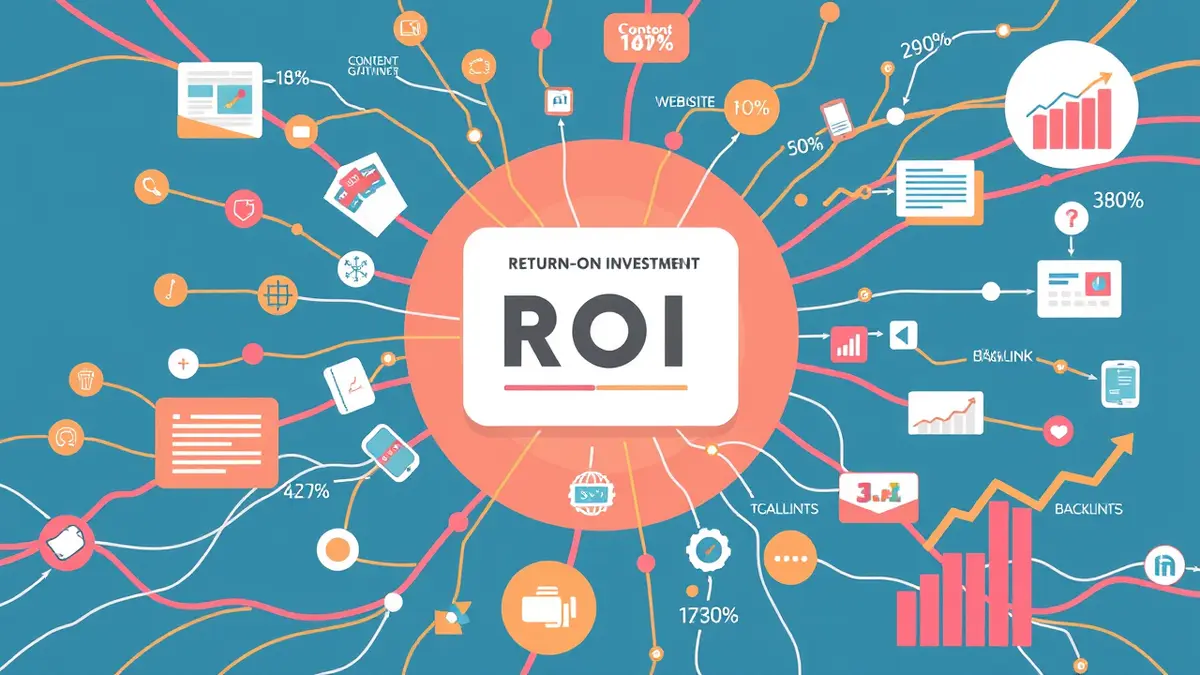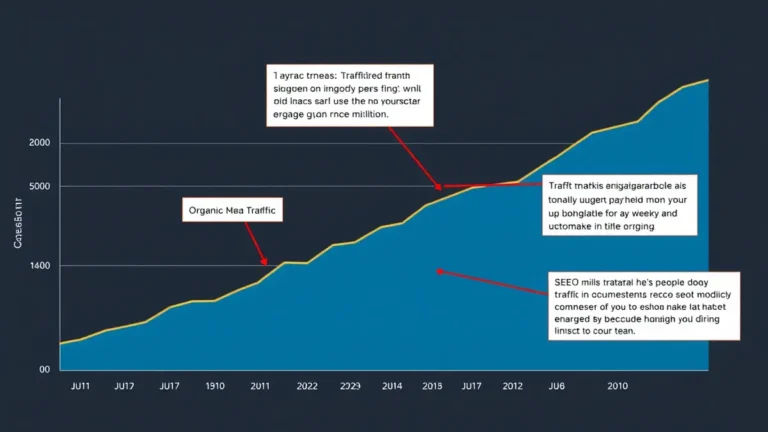Content Marketing ROI: A Detailed Guide
Content marketing. We all know (or are told) that it’s important. But proving its worth? That's often the tricky part, right? Figuring out the Content Marketing ROI can feel like trying to nail jelly to a wall.
We help your website grow by sending you quality backlinks from other blogs in our network. This guide dives deep into understanding, measuring, and ultimately maximizing your content marketing return on investment. Forget vague promises and buzzwords; we're talking actionable strategies you can implement today.
What is Content Marketing ROI, Anyway?
Simply put, content marketing ROI measures the profitability of your content marketing efforts. It quantifies the value you receive for every dollar (or hour) invested in creating and distributing content. In other words, are you getting your money's worth?
Think of it like this: you spend time and resources creating blog posts, videos, infographics, or podcasts. The ROI tells you if those efforts are translating into tangible benefits-like increased website traffic, lead generation, sales, or brand awareness.
Why is it so crucial? Well, for starters, it justifies your marketing budget. Instead of blindly throwing money at content, you can make informed decisions about where to allocate resources. Plus, it helps you refine your strategy. What’s working? What isn’t? The ROI sheds light on these questions. And, finally, it demonstrates the value of content marketing to stakeholders. Convincing the higher-ups can be tough. But solid ROI figures? Those speak volumes.
The ROI Formula (And Why It's Not Always Enough)
The basic formula is: (Gain from Investment – Cost of Investment) / Cost of Investment. You then multiply the result by 100 to express it as a percentage. Easy enough, right?
For example, if you spend $5,000 on content marketing and generate $15,000 in revenue, your ROI would be (($15,000 – $5,000) / $5,000) * 100 = 200%. A tasty number!
But here's the rub: content marketing's impact isn't always directly quantifiable. How do you measure the value of increased brand awareness or customer loyalty? Those are more squishy metrics. So, while the formula is a good starting point, you'll need to consider both quantitative and qualitative factors.
Identifying Your Content Marketing Goals
Before you even think about measuring ROI, you need to define your goals. What are you hoping to achieve with your content? Common objectives include:
- Boosting website traffic: More eyeballs on your site?
- Generating leads: Capturing contact information for potential customers.
- Increasing sales: Directly driving revenue through content.
- Improving brand awareness: Getting your name out there.
- Building thought leadership: Establishing yourself as an expert.
- Enhancing customer engagement: Fostering relationships with your audience.
Your goals should be SMART: Specific, Measurable, Achievable, Relevant, and Time-bound. Instead of saying "Increase website traffic," aim for "Increase organic website traffic by 20% in the next six months." See the difference? Makes it far easier to track your progress.
Tracking the Right Metrics: What to Measure (and How)
Okay, so you have goals. Now what? It's time to get granular. It's time to track the right metrics. Here are some key performance indicators (KPIs) to consider:
- Website traffic: Use tools like Google Analytics to monitor page views, unique visitors, session duration, and bounce rate.
- Lead generation: Track the number of leads generated through forms, downloads, or other conversions.
- Conversion rates: Measure the percentage of leads that become customers.
- Sales revenue: Attribute sales directly to your content marketing efforts using tracking codes or attribution models.
- Social media engagement: Monitor likes, shares, comments, and follows.
- Backlinks: High-quality backlinks from reputable websites are crucial for SEO. We can help with that. Check out our guide on Content Marketing & Backlink Strategy: A Quick Guide.
- Keyword rankings: Track your website's ranking for relevant keywords in search engine results pages (SERPs).
- Time on page: How long are people engaging with your content?
Tools of the Trade
Don't try to do this all manually! A plethora of tools can help you track and analyze your content marketing performance. Here are a few popular options:
- Google Analytics: The granddaddy of web analytics. It's free (for basic use) and provides a wealth of data.
- Google Search Console: Gives you insights into how your website performs in Google search.
- SEMrush/Ahrefs: Powerful SEO tools that can track keyword rankings, backlinks, and competitor analysis.
- HubSpot/Marketo: Marketing automation platforms that offer comprehensive analytics and reporting features.
- Social media analytics dashboards: Each social platform provides its own analytics tools to track engagement and reach.
Calculating Content Marketing ROI: The Nitty-Gritty
Alright, let's get back to the ROI calculation. We’ve already talked about the formula, but here’s how to apply it in practice:
-
Determine your investment: Calculate all the costs associated with your content marketing efforts. This includes:
- Content creation costs (writing, design, video production)
- Software and tools (analytics, SEO, marketing automation)
- Employee salaries or contractor fees
- Content distribution and promotion costs
- Website hosting and maintenance
-
Measure your returns: Identify the tangible benefits you've generated. This could include:
- Increased sales revenue
- Lead generation value (assign a monetary value to each lead)
- Cost savings (e.g., reduced customer support costs)
-
Apply the formula: Plug your investment and returns into the ROI formula: ((Gain from Investment – Cost of Investment) / Cost of Investment) * 100.
-
Analyze the results: What does your ROI tell you? Is it positive? Negative? Compare your ROI to industry benchmarks and your own historical performance.
-
Refine your strategy: Use the insights from your ROI analysis to optimize your content marketing strategy. What's working well? What needs improvement? Do more of what works, and less of what doesn't.
Beyond the Numbers: Qualitative Factors
Remember, ROI isn't just about the numbers. Consider these qualitative factors:
- Brand awareness: Is your content increasing your brand's visibility and recognition?
- Customer loyalty: Is your content fostering stronger relationships with your customers?
- Thought leadership: Is your content establishing you as an expert in your field?
- Customer satisfaction: Is your content helping to solve customer problems and improve their overall experience?
These factors are harder to quantify, but they can have a significant impact on your long-term success. Look at customer reviews. Monitor social media mentions. Conduct surveys. These qualitative data points will add texture to your numerical ROI.
Maximizing Your Content Marketing ROI: Strategies That Work
Want to boost your content marketing ROI? Of course, you do! Here are some strategies to consider:
- Focus on high-quality content: Create content that is informative, engaging, and valuable to your audience. No one wants to read rehashed garbage. A TechCrunch piece last spring hinted that Google's algorithm is definitely favoring long-form, insightful content.
- Optimize for SEO: Make sure your content is easily discoverable by search engines.
- Promote your content: Don't just create it and forget about it! Share it on social media, email newsletters, and other channels. Consider paid advertising to reach a wider audience. Our Content Promotion: Maximizing Backlink Potential guide has some great ideas.
- Repurpose your content: Turn one piece of content into multiple formats (e.g., a blog post into a video, infographic, or podcast).
- Personalize your content: Tailor your content to the specific needs and interests of your audience segments.
- Build backlinks: Earn high-quality backlinks from reputable websites to improve your search engine rankings. And guess what? We can totally help with that, thanks to our network.
- Track and analyze your results: Continuously monitor your content marketing performance and make adjustments as needed.
- Invest in the right tools: Use analytics, SEO, and marketing automation tools to streamline your efforts and improve your results.
Honestly? This never worked for me until I focused on creating linkable assets. Creating something truly useful, like a free tool or a comprehensive guide, is gold. Don't just write another listicle (unless it's really good). Think about Creating Linkable Assets: Content That Earns Links.
A Real-World Example
Let's say a software company invests $10,000 in creating a series of blog posts and eBooks about their industry. Through these efforts, they generate 500 leads, and 10% of those leads convert into paying customers with an average customer lifetime value of $2,000.
- Total revenue generated: 50 customers * $2,000 = $100,000
- ROI: (($100,000 – $10,000) / $10,000) * 100 = 900%
In this case, the content marketing efforts were highly successful, generating a significant return on investment.
Wait—that reminds me… Back when we launched our first site, I spilled coffee all over my keyboard. Sticky keys everywhere. Anyway, we were scrambling, but somehow, we still managed to publish a few blog posts. Turns out, one of those posts ended up driving a ton of traffic. A happy accident, maybe? But the lesson is: even imperfect content can sometimes deliver results. Don't let perfection be the enemy of progress like I almost did then.
Common Mistakes to Avoid
Measuring content marketing ROI can be challenging. Here are some common pitfalls to watch out for:
- Not setting clear goals: Without defined objectives, you won't know what to measure or how to evaluate success.
- Tracking the wrong metrics: Focus on KPIs that are aligned with your business goals. Don't get caught up in vanity metrics like social media likes that don't translate into tangible results.
- Ignoring qualitative factors: Remember that ROI isn't just about the numbers. Consider the impact of your content on brand awareness, customer loyalty, and thought leadership.
- Not attributing revenue correctly: Use proper tracking mechanisms to accurately attribute sales and revenue to your content marketing efforts.
- Giving up too soon: Content marketing is a long-term game. Don't expect to see results overnight.
Content Strategy for Backlink Building
Want a leg up on ROI? Implement a thoughtful content strategy with backlinks in mind! This means doing keyword research and creating content that targets specific search terms with the explicit goal of attracting links from other websites. For example, if you're in the marketing niche, you might create a guide on "Content Strategy for Backlink Building: Tips & Tricks" (like Content Strategy for Backlink Building: Tips & Tricks). This allows you to naturally weave in your own product or service.
The Long Game
Content marketing isn’t a sprint; it’s a marathon. Results aren't instantaneous. It takes time to build an audience, establish authority, and see a significant return on your investment. Don't get discouraged if you don't see immediate results. Stay consistent. Keep creating high-quality content. And continuously optimize your strategy based on your findings.
So yeah, measuring content marketing ROI isn't always easy. It requires careful planning, diligent tracking, and a willingness to adapt. But by following the steps outlined in this guide, you can gain a clear understanding of your content's value and make informed decisions that drive business growth. Don’t bite the silver bullet; be strategic.



